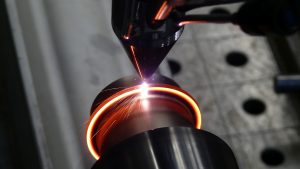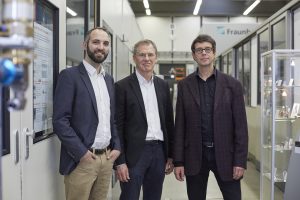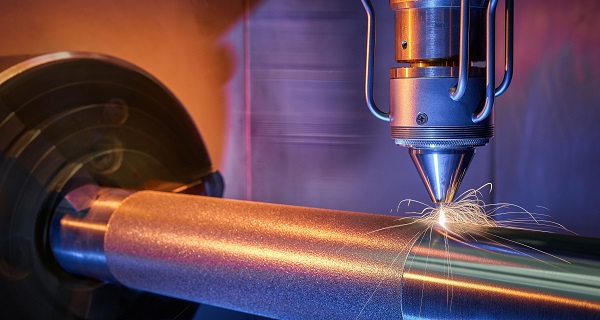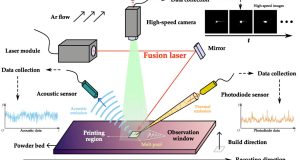Components are protected against corrosion and wear through hard chrome plating, thermal spraying, laser material deposition or other deposition welding techniques. However, there are downsides to these processes – for example, as of September 2017, chromium(VI) coatings will require authorization. Researchers from the Fraunhofer Institute for Laser Technology ILT in Aachen as well as the RWTH Aachen University have now developed an ultra-high-speed laser material deposition process, known by its German acronym EHLA, to eliminate these drawbacks. On May 30, 2017, the research team was awarded the Joseph von Fraunhofer Prize for this work.
Protecting components against corrosion and wear is no simple matter. Standard processes such as hard chrome plating, thermal spraying and deposition welding have drawbacks. Up to now, laser material deposition has been used only in specific applications. With ultra-high-speed laser material deposition, or EHLA, researchers at Fraunhofer ILT in Aachen and RWTH Aachen University have developed and patented an alternative process to overcome shortcomings of the conventional processes in the areas of coating technology and repair. “We can now use EHLA to apply thin layers in the range of a tenth of a millimeter over large surfaces within a short time, while being resource-efficient and economical,” Dr. Andres Gasser, group manager at Fraunhofer ILT, summarizes.
An Alternative to Hard Chrome Plating
One of the most common processes for the application of corrosion and wear protective coatings is hard chrome plating. However, this consumes a lot of energy. In addition, chromium(VI) harms the environment – which is why, from September 2017, it can only be used with specific authorization. EHLA now offers companies an economical alternative. Its chemical-free application makes the process very environmentally friendly. The resulting layer is metallurgically bonded to the base material and, unlike hard chrome layers, does not delaminate. While hard chrome plating layers have pores and cracks, layers produced using EHLA are non-porous and, thus, offer more efficient long-term protection.
More Efficient Use of Resources than Thermal Spraying
Thermal spraying, too, has disadvantages. This process consumes a lot of material and gas because only about half of the material used ends up coating the component surface. In addition, the resulting layers bond only weakly to the substrate. Due to their porosity, it is necessary to apply several layers, each roughly 25 to 50 micrometers thick, on top of each other. In comparison, the new EHLA process uses about 90 percent of the material, making it far more resource efficient and economical. Not only are the individual layers non-porous, they also bond firmly to the substrate.
Faster and More Broadly Applicable than Deposition Welding Processes
Deposition welding processes are used to produce high-quality and firmly bonded coatings. With conventional processes such as tungsten inert gas (TIG) welding or plasma powder deposition, however, the layers of 2 to 3 mm are often far too thick and, as a result, too much material is used. Laser material deposition already allows for far thinner layers – between 0.5 and 1 millimeter, but is too slow for large components, which is why it has only been used for specific applications so far. A further drawback of the process is that it requires a certain melt pool size in order to create a defect-free layer: the component is locally melted, while a powder nozzle directs a powdery additive into the melt pool. Dr. Gasser explains the key element of the new process: “With EHLA, the laser melts the powder particles while they are above the melt pool.” Since this means that drops of liquid material fall into the weld pool instead of solid powder particles, the layer becomes more homogenous. In addition, less base material needs to be melted: instead of up to a millimeter, now only a few micrometers suffice.

© Fraunhofer ILT, Aachen, Germany.
As a result, the component can be coated 100 to 250 times faster than with conventional laser material deposition, with minimal heating of the substrate. Thus, EHLA facilitates the coating of heat-sensitive components, which was impossible due to excessively high heat input up to now. Also, the new process can be used for completely new material combinations such as coatings on aluminum base alloy or cast iron.
In close cooperation with ACunity GmbH from Aachen, Germany, which is a spin-off of the Fraunhofer ILT, the Dutch company Hornet Laser Cladding B.V. will deliver the first EHLA system to China in the near future. It shall be used for research purposes and industrial applications at the Advanced Manufacture Technology Center of China Academy of Machinery Science & Technology CAMTC in Beijing.
At this year’s LASER World of PHOTONICS from June 26 to 29 in Munich, Germany, our experts will be presenting the EHLA process (stand A2.431).
Honored with the Joseph von Fraunhofer Prize 2017

© Piotr Banczerowski / Fraunhofer.
At the Fraunhofer General Assembly Meeting, held on May 30 in Dresden, Germany, Dr. Andres Gasser, Thomas Schopphoven and Gerhard Maria Backes received the Joseph von Fraunhofer prize, which carries a reward of 50,000 euros, in recognition of their work.
Subscribe to our Newsletter
3DPResso is a weekly newsletter that links to the most exciting global stories from the 3D printing and additive manufacturing industry.



























